You may encounter serious problems with your fire alarm system when switching to VoIP telephone lines. The following steps will help you avoid them.
Copper-based phone networks across the country are rapidly being replaced by fiber optic networks. Telecommunication providers typically do not actively maintain POTS (Plain Old Telephone Service) lines and as a result they are completely disappearing. You will likely only see VoIP (Voice over Internet Protocol) packages available if you contact your local carrier about adding new business phone lines. Although VoIP technology offers many benefits, such as improved phone functionality and lower costs, it may negatively impact your fire alarm system.
POTS vs. VoIP
Twisted copper wires are used in traditional POTS lines. The voice traffic on POTS lines is transmitted over a specific copper wire, resulting in a low delay and high reliability. Using VoIP technology, voice calls are digitally compressed and transmitted over the internet as data packets. There are typically 20 milliseconds of voice data in each data packet. Once these packets reach their destination they are reassembled and converted from digital to analog. This makes the voice sound smooth and continuous.
The Effects On Fire Alarm Systems
Two POTS lines are usually connected to commercial fire alarm panels. Each panel is equipped with central station transmitters that send information to a monitoring station when trouble is detected, for example smoke, heat, or carbon monoxide. A unique form of data transmission is used today for most fire alarm signals in order to acquire complex information very quickly and send it to the monitoring center. In the process of changing POTS lines to VoIP, alarm signals can become unrecognizable to the monitoring center. Due to the way VoIP technology sends alarm signals, the data format of the signal changes during transmission.
Almost always, the monitoring center stops receiving signals from the fire alarm panel after the POTS lines are converted to VoIP lines. This is a common problem and it’s important to act quickly to remediate the situation for the customer. During this process it can be very stressful for everyone involved when the monitoring center makes necessary calls to unexpected customers. Planning ahead can help you avoid surprise fire drills. There are two main ways to accomplish the transition with minimal complications.
MFVN & Network/Cellular Communicator

Most customers find that switching their existing POTS lines to Managed Facility Voice Network or MFVN lines is the most economical and easiest solution for their fire alarm systems. New MFVN lines can be plugged into your fire alarm system without making any changes to its setup. In the use of MFVNs, the public switched telephone network (PSTN) is interconnected with the physical network.
As a result, they work in the same way as traditional POTS lines. For example, there is a disaster recovery plan that covers major and minor catastrophes, and above all, they transmit fire alarm signals without interruption.
Another option is a network or cellular communicator which uses two communication methods. Internet connections are the primary method of connection, and cellular networks are the secondary method. As a result, a fire alarm panel can still transmit signals to a monitoring center via the cellular network even if there’s an internet outage in a building. When using POTS lines signals typically take 30 seconds to reach their destination, however, network/cellular transmitters send fire alarm signals instantaneously. During an emergency situation, every second can be critical in stopping a fire in time.
Benefits To Upgrading
It’s also possible to save up to $1,000 annually with a network/cellular communicator by eliminating two expensive POTS lines. In order to make the conversion as seamless as possible, your fire alarm vendor may have to modify the settings or upgrade the panel, depending on the brand and model of the central station transmitter.
Whether your POTS lines are working today or not, you should future-proof your fire alarm panel proactively because POTS will be obsolete in a matter of time. An MFVN as well as a network/cellular communicator are both viable alternatives. As a fire alarm system provider RC Security can help you determine the best option for your company.
If you are looking to update security features for your business, like replacing your POTS Lines let RC Security help. Our continued research and partnerships with premium brands allow us to offer better quality every time.
About RC Security Consulting
RC Security Consulting protects the heart of Texas with design, installation, retrofit, repair, inspection, and monitoring of commercial security systems. We are centrally located in Collin County and provide service for almost 200 miles in all directions. Connect with us on LinkedIn to learn more.


